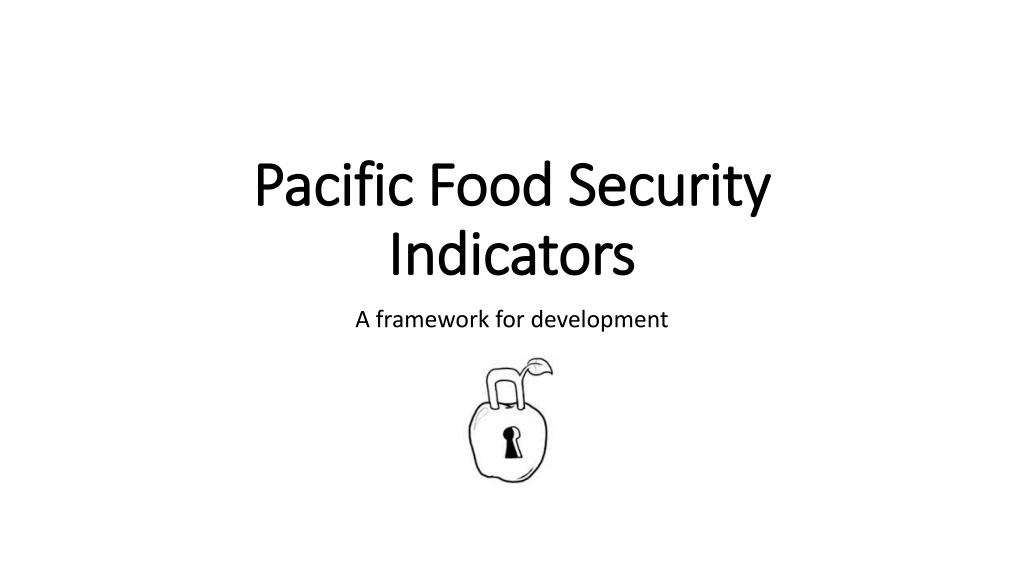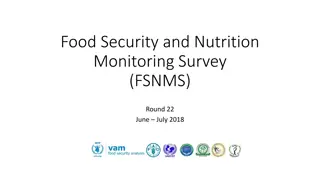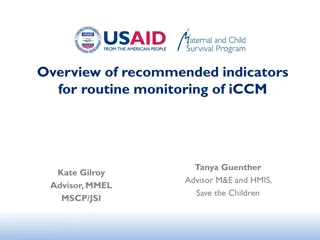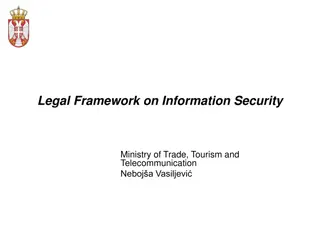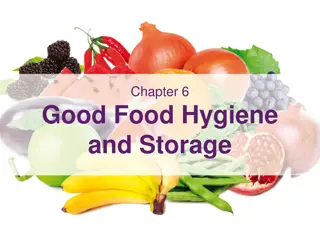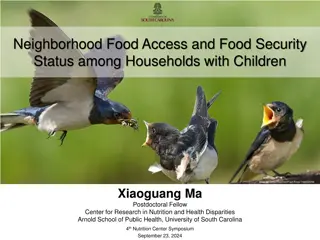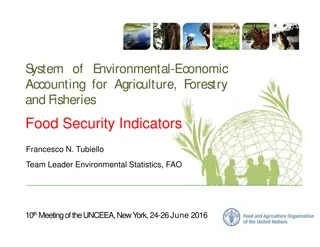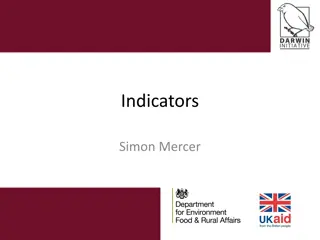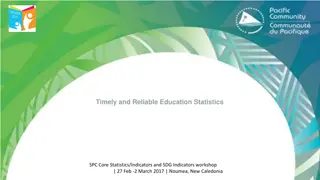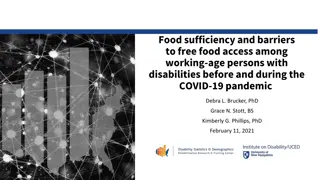Pacific Food Security Indicators Framework
This content explores the development of a framework for Pacific food security indicators, highlighting the importance of measuring availability, access, utilization, and stability in the food sector. It discusses the impact of multiple sectors on food security, identifies key indicators, and emphasizes the need for investment in improving food security measures. The content also delves into specific indicators related to agriculture, health, education, food industry, trade, environment, and more, with a focus on stimulating discussions and supporting phased approaches for development.
Download Presentation

Please find below an Image/Link to download the presentation.
The content on the website is provided AS IS for your information and personal use only. It may not be sold, licensed, or shared on other websites without obtaining consent from the author.If you encounter any issues during the download, it is possible that the publisher has removed the file from their server.
You are allowed to download the files provided on this website for personal or commercial use, subject to the condition that they are used lawfully. All files are the property of their respective owners.
The content on the website is provided AS IS for your information and personal use only. It may not be sold, licensed, or shared on other websites without obtaining consent from the author.
E N D
Presentation Transcript
Pacific Food Security Pacific Food Security Indicators Indicators A framework for development
Background Background Towards a Food Secure Pacific 2010-2015 . Pacific Food Summit 2010. Theme 6: Food security information system WHO study in Fiji and Tuvalu SPC (SDP) + FBOS + VNSO- list of indicators at national, local, household and individual level which address availability, access, utilisation and stability. Result- 142 food security indicators
Agriculture Health Education Food Industry Trade Environment Consumers Fisheries Communication Energy Transport Government Demography Employment Availability Utilisation Stability Access
Study Study Pacific Food Security Indicators. A framework for Development, 2014 Stimulate discussion Support a phased approach by: Identifying available and high quality food security indicators Identifying indicators for greater investment.
Methodology Methodology 1. Which indicators capture the impact of multiple sectors on food security? Rationale: efficient, broad interest, galvanise support for further development Examples: Food Production Index, prevalence of underweight children under 5 yrs. 47 47 142 142
2. Which ones are currently measurable, regularly collected and available for many PIs? 18 18 47 47
Availability X X X X X X X Utilization X X X X X X X X X Indicator Low birth weight babies Prevalence of overweight adults Prevalence of obese adults Prevalence of obese children (0-5 yrs.) Prevalence of obese children (13-15 yrs.) Prevalence of adult diabetes Prevalence of underweight children under 5 yrs. Infant mortality rate Life expectancy at birth (by gender) Food import dependence % of food imports as a % of total imports % of food exports as a % of total exports Food trade balance Food import capability index Food import months % of household expenditure on food Average per capita calorie consumption % Change in Food Consumer Price Index Stability Access X X X X X X X Sector No. 36 Health 37 Health 38 Health 39 Health 40 Health 41 Health 42 Health 49 Health 50 Health 67 Trade 68 Trade 69 Trade 70 Trade 74 Trade 76 Trade 110 Consumers 113 Consumers 119 Consumers X X X X X X X X X X X X X X
3. Repetitive? Best indicator for the measure? Example: Food import dependency ratio favoured over other trade indicators because it captures food imports, exports and agriculture contribution to GDP 18 18 5 5
Suggested priority indicators Suggested priority indicators 1. Prevalence of obese adults 2. Prevalence of underweight under 5 s 3. Food import dependence 4. % of household expenditure on food 5. % change in food CPI
Medium term Medium term Measures of micronutrient deficiency (i.e. anemia, vitamin A); Measures of calorie supply, including production variability and adequacy; Measures of calorie consumption, particularly composition and access; Indicators on post-harvest losses and food storage and preservation; Sources of household food consumption (i.e. home grown or imported); Additional measures of food price levels and volatility; Legislative issues around food quality and control by government; Impact of natural disasters on food security.
Food Security indicators Rationale Prevalence of obese adults Top FS indicator + Common national ag indicator Food indicators Prevalence of underweight children Top FS indicator + Common national ag indicator + SDG Food import dependence Top FS indicator + strong links with common national ag indicators % household expenditure on food Top FS indicator + easily obtainable from HIES % change in Food CPI Top FS indicator Measures of micronutrient deficiency Attainable from HIES research for SDGs Measure of calorie consumption Attainable from HIES research for SDG 2.1.1 Contribution of local production to diets Common national ag indicator + original NMDI
Now your turn? Now your turn? Comments on the approach/methodology? Comments on the indicators emerging? Big gaps?
